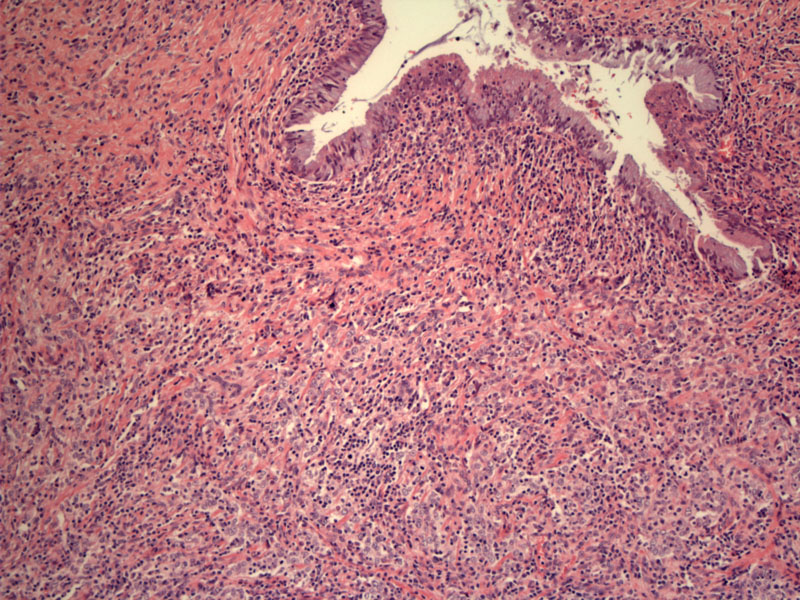

An endocervical gland is seen on top with tumor forming broad sheets at the bottom image. Note the presence of numerous lymphocytes admixed with the infiltrating tumor cells.
Syncytial broad sheets of tumor cells with vesicular nuclei and prominent nucleoli. There is no overt squamoid differentiation.
A brisk lymphocytic infiltrate can be appreciated. There is a uniformity to malignant epithelial cells, as they resemble each other in size and shape.
When encountering a lymphoepithelial carcinoma, one generally thinks of the nasopharynx. These tumors are composed of sheets of neoplastic cells with prominent nucleoli accompanied by an intense lymphocytic infiltrate. Morphologically identical tumors have been identified in the stomach, salivary gland, lung and uterine cervix and are called lymphoepithelioma-like carcinomas(LELC).
Although its infiltrative and diffuse morphology may be alarming, LELC of the uterine cervix tends to have a better prognosis than poorly differentiated squamous cell carcinomas, therefore, it is important to recognize this entity even though it is quite rare and accounts for less than 1% of all primary uterine tumors.1
EBV (Epstein-Barr Virus) is strongly associated with lymphoepithelial carcinoma in the nasopharynx, however, the role of EBV in LELC of the uterine cervix has not been clearly established. Due to the rarity of these tumors, large scale studies are not feasible. Published studies suggest that EBV may play a stronger role in Asian patients, whereas EBV positivity (as demonstrated by EBER in situ hybridization) is usually absent in Western patients. Furthermore, the incidence of LELC of the uterine cervix is higher in Asian countries, following a similar epidemiology of its nasopharnygeal counterpart.1,2
The prognosis of LELC of the uterine cervix appears to be more favorable than squamous cell carcinoma of comparable stage. These tumors generally present in early stages and are less likely to metastasize -- patients appear to be largely disease-free after surgical resection.1,2
• Nasopharynx : Nasopharyngeal Carcinoma
• Stomach : Lymphoepithelial-like Gastric Carcinoma
• Thymus : Thymic Carcinoma, Lymphoepithelial Type
1 Takai N, Nakamura S, Goto K, et al. Lymphoepithelioma-like carcinoma of the uterine cervix. Arch Gynecol Obste 2009;280:725-727.
2 Chao A, Tsai CN, Hsueh W, et al. Does Epstein-Barr Virus Play a Role in Lymphoepithelioma-like Carcinoma of the Uterine Cervix? International Journal of Gynecological Pathology 2009;28:279-285.
Slides courtesy of Dr. Lida Crooks, Dept of Pathology at VAMC, Albuquerque NM.